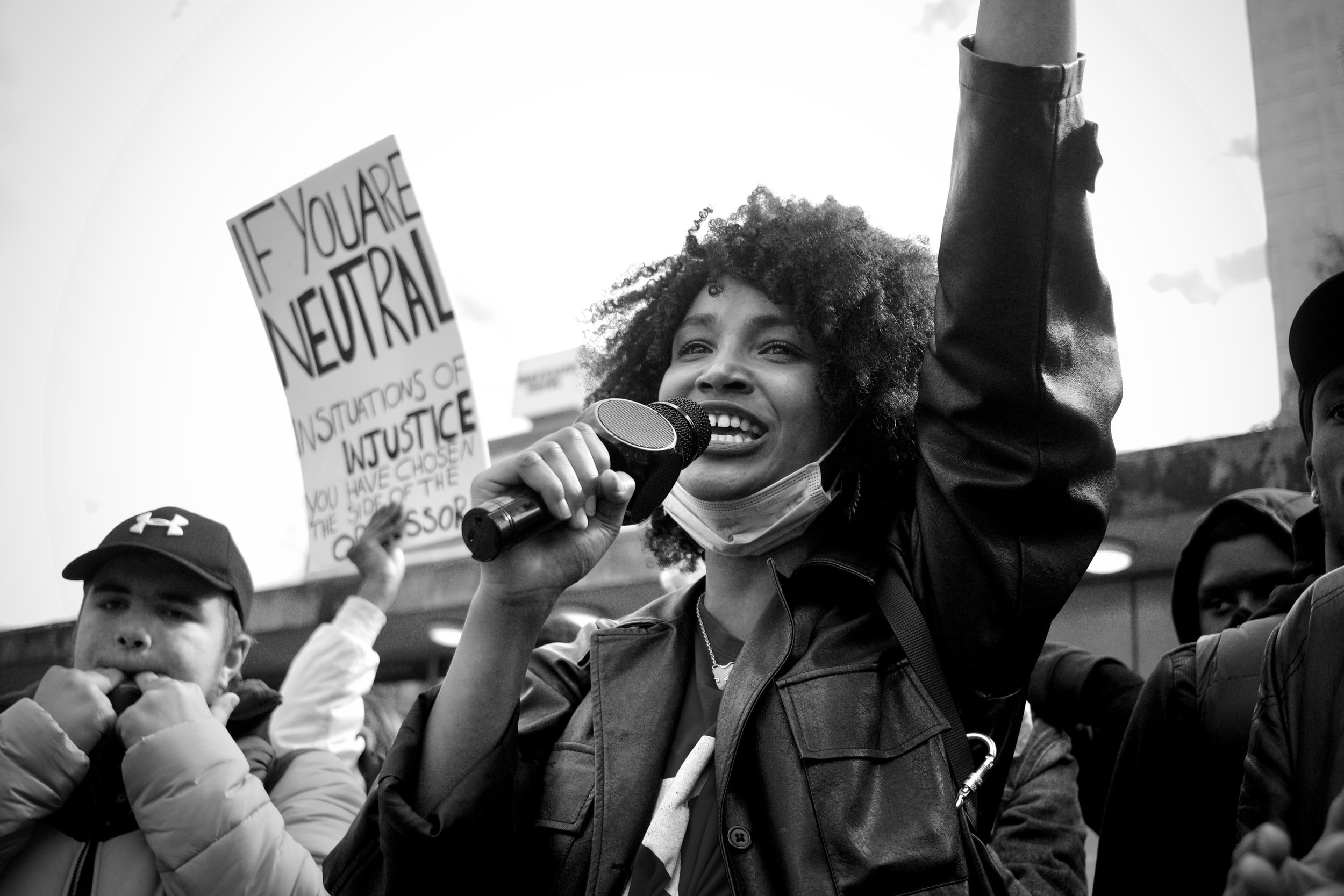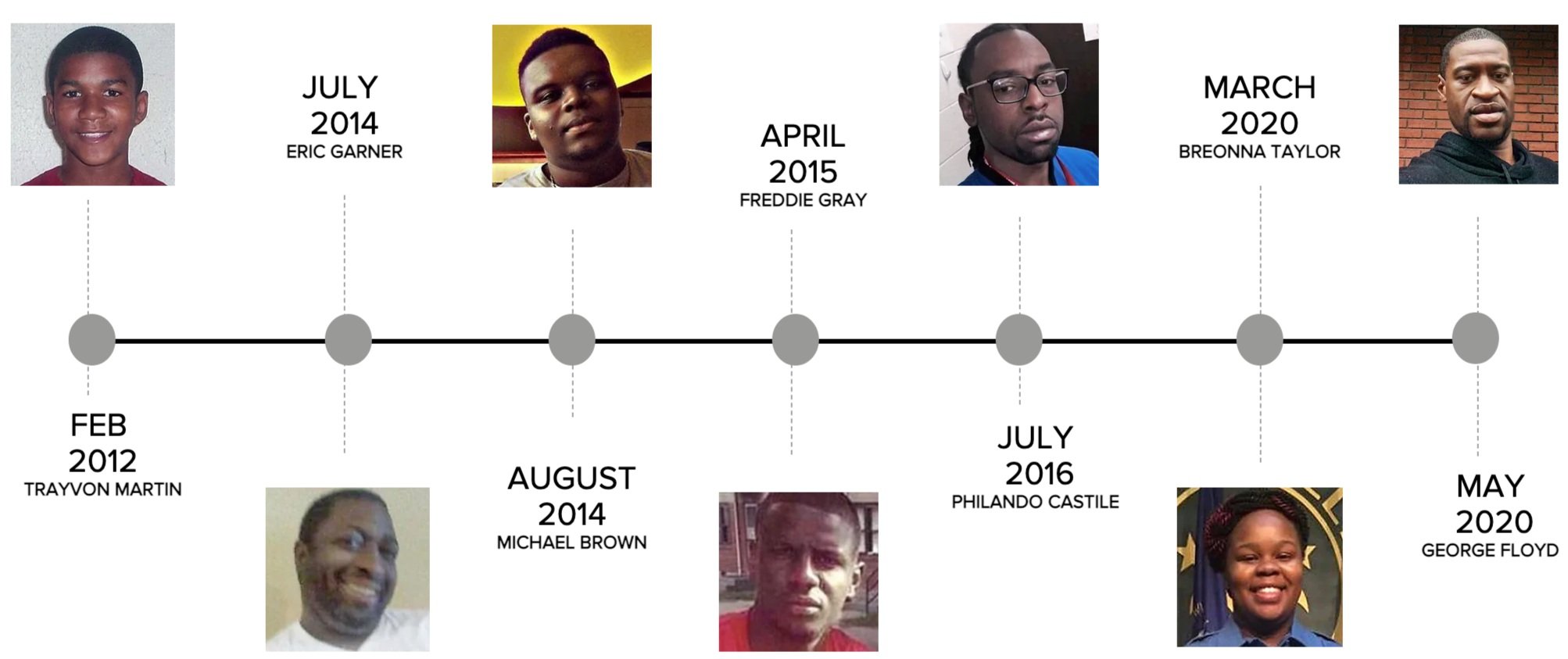
History of BLM engagement.
It is no secret that the spirit of the Black Lives Matter Movement has been promoted by Black Americans long before its most recent rise in publicity following the murder of George Floyd.
This gap in racial advocacy between the Black American community and the general American public has been repeatedly reflected in police brutality events since the beginning of the Black Lives Matter movement in 2012.
The percent change in volume of search trends in the United States from 2012 to 2020 using Google trends’ “Rising Trends” and “Interest over time” features. Interact with the visualization here.
2012 is marked as the beginning of the Black Lives Matter Movement due to the public’s outrage of Trayvon Martin’s murder. In February of that year, seventeen-year-old Trayvon was walking home from the store, completely unarmed when he was identified as a ‘suspicious person’ by neighborhood watch officer George Zimmerman and shot in the back of the head.
Outrage bubbled in Trayvon’s Florida hometown and quickly spread nationwide as Black Americans expressed their community’s heartbreak surrounding anti-black racism to the rest of America. Reaching out to the Black community for support, grief-stricken Patrisee Cullor and Alicia Garza developed the #BlackLivesMatter hashtag on Facebook. It swept the nation as Black Americans and allies expressed their grief of Trayvon’s murder as a rallying cry to end police brutality. The #BlackLivesMatter movement gained even more traction following George Zimmerman’s trial. Despite his charge of second-degree murder, Zimmerman was not found guilty and was acquitted of all charges.
Although Zimmerman himself was not a police officer, the Black community took the failure to prosecute Zimmerman as a blatant disregard for Black lives everywhere. Through continued use of #BlackLivesMatter, a global movement was launched to “eradicate white supremacy and build local power to intervene in violence inflicted on Black communities by the state and vigilantes” in defense of Black lives.
This activism that launched the Black Lives Matter movement forced America to pay attention to the multitude of crimes against Black Americans through police brutality. For this reason, we have included the murder of Trayvon Martin in our analysis of “publicized” (featuring high media coverage and public engagement) police brutality incidents in America. As the most nationally publicized police brutality incident, Trayvon's murder in 2012 marks the beginning of the inconsistent history of public engagement surrounding the modern Black Lives Matter movement.
From slave abuse to lynching and police brutality, there have been thousands of murder cases against Black people at the hands of police and government officials. While still acknowledging these lost lives and their families, we have chosen a sample of these incidents to focus on in our data and analysis.
Seven of the most well-known police brutality incidents from 2012 to 2020 that have been prominent through media engagement and social trends are featured above. Even within this sample, levels of public engagement have fluctuated greatly- highlighting the lack of longevity associated with the coverage of the movement. As we will continue to explore, this lack of awareness creates inaction that deepens America’s Anti-Black racial inequality chasm.
Preceding George Floyd’s murder, there had not been a peak in any actionable Google search query related to the Black Lives Matter Movement since 2015. Actionable search queries have been categorized by keywords that show an intent to provide tangible support to the Black Lives Matter movement through donating or protesting. Other search queries such as ‘Police Brutality’ are categorized as unactionable as they are most often informational searches not coupled with tangible action.
The change in volume of search trends in the United States relating to the Black Lives Matter movement from 2012 to 2020 using Google Trends’ “Top Search” and “Interest over time” features. Interact with the visualization here.
Out of the unactionable trending search queries, ‘Police Brutality’ had the most activity. Even so, there has not been a peak in either actionable or unactionable search queries since 2015.
While the actionable search queries such as “Donate Black Lives Matter” and “Protests Near Me” averaged at zero from 2012-2019, “Protests” and “Police Brutality” had a much higher search average over the years. Even so, these peaks coincide only with specific incidents of police brutality media coverage and decrease quickly after.
The change in volume of ‘Police Brutality’ search trend in the United States from 2012 to 2020 using Google trends’ “Interest over time” feature. Interact with the visualization here.
In 2015, #blacklivesmatter peaked in April and declined to its lowest level in August before rising again in September. Peak engagement follows Freddie Gray’s murder before decreasing. This is a pattern in online engagement following other high-profile murders of unarmed Black people by police officers.
This pattern of rapid spikes in engagement followed by months of minimal engagement applies to the seven murders of black men and women in our timeline.
Unfortunately, the increased search popularity of police brutality was still low in volume and did not become an overall top search. In fact, during the week following Gray’s murder, 0 of the 25 top search trends were associated with the Black Lives Matter movement or police brutality. This same trend of quickly decreasing interest and overall lack of engagement from Americans who are not committed to engagement can be seen throughout the majority of police brutality incidents.
Google Trends lists the top 18 to 25 rising trends for any given day based on search volume. The black bar measures the number of overall top rising trends for that day in the United States. The gray bar measures the proportion of top rising trends that relate to the BLM movement in the United States. Interact with the visualization here.
The above graph tracks the proportion of overall trending Google searches made following 7 days after each murder from the aforementioned sample to the trending Google searches to BLM relevant searches. It is unsurprising yet sad that such a small fraction of the country was making searches relevant to these murders. During these individual times, top search trends were consistently celebrity gossip and sports news. It is sobering to realize that Americans searched pop culture more than the tragic events affecting the Black community.
It can be seen that generally since 2015 (excluding the silence immediately following Breonna Taylor’s murder, most likely attributed to the COVID-19 global pandemic) more Americans are searching these relevant topics.
But why does it take so many incidents of police brutality murders for America to recognize the dire need for change? Will this current attention to the Black Lives Matter movement even last?
America has a historical tendency since the birth of the Black Lives Matter movement to quickly and routinely forget the suffering of the Black American community. To promote equality and for the deaths of these individuals to spur change, it is increasingly important that the momentum associated with George Floyd’s murder is continued and supported with tangible action steps to end anti-Black racism.


